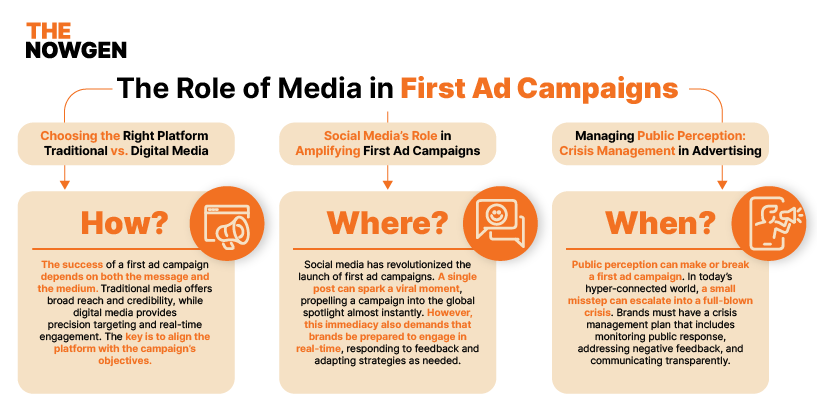
In the fast-paced world of advertising, the first impression is everything. A brand’s debut in the market is not just an introduction; it’s a statement of intent. The first ad campaign serves as the initial handshake, setting the tone and creating anticipation. It’s a cornerstone of identity and a promise of what’s to come, making it much more than just a marketing tactic—it’s the foundation of a brand’s identity.
The Role of Innovation in Advertising Success
Innovation is the lifeblood of successful advertising. In a landscape flooded with messages, standing out requires more than creativity—it demands a fresh perspective, the courage to break from the norm, and a willingness to take risks. Without innovation, even the most well-crafted message can get lost in the noise.
Why First Ad Campaigns Matter: A Historical Perspective
First ad campaigns have always been crucial in shaping the trajectory of brands. History is full of examples where powerful first campaigns set the stage for decades of success. These campaigns become defining moments, serving as benchmarks of creativity and innovation, influencing the direction of advertising for years to come.
Innovative Strategies in First Ad Campaigns
Disruptive Thinking: Breaking the Mold with Fresh Ideas
Disruptive thinking challenges the status quo, dares to be different, and finds new ways to communicate the brand’s message. Whether through unconventional storytelling, unique media strategies, or unexpected partnerships, this approach is key to making a lasting impact.
Leveraging Technology: The Digital Shift in First Ad Campaigns
The digital revolution has transformed advertising, offering new opportunities for innovation. Social media, influencer marketing, programmatic advertising, and AI-driven personalization allow brands to reach a wider audience, engage in real-time, and measure campaign effectiveness with unprecedented accuracy. However, the key lies in using technology strategically to enhance, not overshadow, the campaign.
The Power of Simplicity: When Less is More
In an age of information overload, simplicity is often the most powerful tool. Successful first ad campaigns don’t need to be complex to be effective. By focusing on a clear, concise message, brands can cut through the noise and create campaigns that are both impactful and timeless.
Case Studies: Icons of Innovation
- Coca-Cola’s First Campaign: The Birth of a Beverage Empire
- Coca-Cola’s first ad campaign introduced the brand as more than just a drink—it was a lifestyle. The campaign’s success lay in creating a strong brand identity that resonated with consumers, setting the stage for Coca-Cola to become a global icon.
- Nike’s Just Do It: Turning a Slogan into a Movement
- Nike’s Just Do It campaign is a masterclass in the power of a slogan. What began as a simple phrase quickly evolved into a global movement, inspiring millions to push beyond their limits. Its success is rooted in emotional appeal and the campaign’s ability to tap into the universal desire for self-improvement.
- Apple’s Think Different: The Ad That Changed Everything
- Apple’s Think Different campaign marked a turning point for the company. By celebrating creativity and challenging the norm, Apple revitalized its brand and solidified its position as a leader in the tech industry.
The Role of Media in First Ad Campaigns

Choosing the Right Platform: Traditional vs. Digital Media
The success of a first ad campaign depends on both the message and the medium. Traditional media offers broad reach and credibility, while digital media provides precision targeting and real-time engagement. The key is to align the platform with the campaign’s objectives.
Social media has revolutionized the launch of first ad campaigns. A single post can spark a viral moment, propelling a campaign into the global spotlight almost instantly. However, this immediacy also demands that brands be prepared to engage in real-time, responding to feedback and adapting strategies as needed.
Managing Public Perception: Crisis Management in Advertising
Public perception can make or break a first ad campaign. In today’s hyper-connected world, a small misstep can escalate into a full-blown crisis. Brands must have a crisis management plan that includes monitoring public response, addressing negative feedback, and communicating transparently.
The Future of First Ad Campaigns
- Emerging Trends: What’s Next in Advertising Innovation
- The advertising landscape is constantly evolving. Immersive experiences like virtual and augmented reality, personalized messaging powered by AI, and a growing emphasis on social responsibility are shaping the future of first ad campaigns. Brands that embrace these trends will set the stage for long-term success.
- AI and Automation: The Next Frontier for First Ad Campaigns
- AI and automation are revolutionizing how first ad campaigns are created and delivered. From real-time optimization to personalized content generation, these technologies offer exciting possibilities. However, brands must balance technology with creativity to ensure their campaigns remain authentic.
- Sustainability and Ethics: The New Standards for Success
- Sustainability and ethics are now essential components of successful campaigns. Consumers demand transparency and responsibility from the brands they support. By integrating these values into their campaigns, brands can build trust, differentiate themselves, and resonate on a deeper level.
The future of advertising depends on fresh ideas and new perspectives. It’s vital to foster curiosity and experimentation, encourage young talent to challenge the status quo, and provide them with the tools they need to succeed. By mentoring the next generation, today’s leaders can ensure the spirit of innovation continues to drive groundbreaking campaigns.



